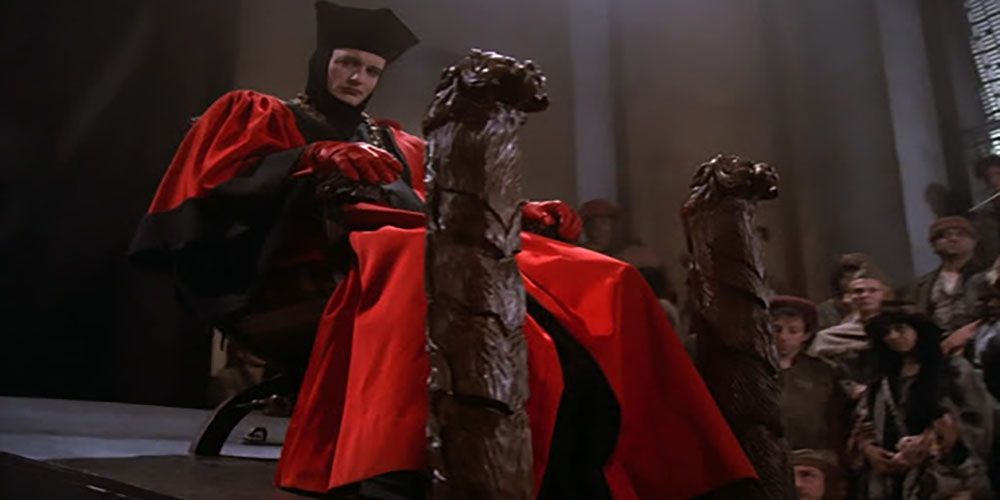
From its first episodes, Star Trek has been a franchise about humanity, and its potential to evolve into a better version of itself. Gene Roddenberry's passion project set out to explore new worlds, and the ethical and moral outcomes of often painful decisions. But buried in Trek's lore is the secret key as to why its utopian standards are so important to its civilization. World War III had scorched the Earth, and the scars of the post-atomic horror were still fresh when the United Federation of Planets was founded.
The roots of that final World War are slightly confusing. The original 1966 Star Trek series introduced the Eugenics War in "Space Seed," a conflict that burned through the 1990s as an army of genetically engineered humans tried to overtake Earth. The tyrannical Khan Noonian Singh was arguably the most peaceful of these superhuman warlords, but millions of lives were still lost. Though Spock calls this the Third World War, 1969's "The Savage Curtain" introduces a figure that later becomes the architect of a "true" world war in the mid 21st century, Colonel Green.

Colonel Phillip Green is described in "The Savage Curtain" as the leader of a genocidal war. Star Trek: Enterprise followed up on Green's history, with an infographic seen in "In a Mirror, Darkly," naming him responsible for thirty-seven million deaths. The fourth season Enterprise episode "Demons" would then offer a stark new clarity to Green's actions. Obsessed with human genetic purity after years of radiation exposure due to a world war he engineered, Green continued to call for genocide to purge undesirable genetics from the human race. Green is the architect of a horror that continued for decades after the atomic war.
Despite Green's demand for further slaughter, humanity slowly began to recover. Less than a decade after his gruesome speech, scientist and inventor Zefram Cochrane would make first contact with the Vulcans in 2063. It was a watershed moment for humanity, the first step towards that better future and its network of allied worlds. But it didn't change the world overnight. Pockets of irradiated land and genetic mutants would persist into the 22nd century and, with them, chaos and distrust would continue to mar Earth.
Star Trek: The Next Generation premiered in 1987 with the feature-length two-part story "Encounter at Farpoint." Fan-favorite character Q (John de Lancie) makes his introduction virtually alongside the new crew, and the omnipotent alien is here to put humanity on trial. He uses a post-World War III tribunal hall to do it, providing the franchise's first glimpse of the fallout and the chaos that laid the foundation for today's Federation. Among Q's throng are drug-addled soldiers, mutants and poverty-stricken rabble, who care more about entertainment than actual justice. As Picard notes, the hall appears as it would have been, and Troi, the Betazed empath, remarks on its lack of illusion.

Set a century prior to Captain Kirk's era, Enterprise would reveal that the war and its ghastly aftermath had already become fuel for award-bait films. Yet the trials of the post-atomic horror had one last challenge to offer mankind, rooted in all-too-familiar xenophobia. The 22nd century saw the Terra Prime terrorist movement attempt to echo similar real-world attempts to gin up the hate, expulsion and murder of those deemed "other." Terra Prime and its founder, John Paxton, not only believed in the genocidal purity ethics of Colonel Green but held the Vulcans directly responsible for not intervening earlier, preventing the war and its horrific aftermath.
Terra Prime's extremist views came to include seeing all non-human life as a threat, and they engaged in a series of attempts to destroy the Federation. The crew of the NX-01 Enterprise managed to corner Paxton and arrest him. Paxton's attempt to build a separatist Earth by humans and for humans ultimately failed. By Picard's era, the horrors of WWIII and its aftermath had at last become fodder for the history books, an era to learn from and to never repeat.
With series creator Gene Roddenberry a veteran of the last world war, the warnings of the outcome of another great and terrible war is more than window dressing. Like fellow creator Rod Serling, buried inside Roddenberry's most famous work is the never-ending plea to humanity to be better. And with more than words, Star Trek has shown its audience horrific but useful glimpses of what the consequences should be if humanity ever fails its greatest test.
0 Comments